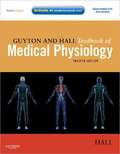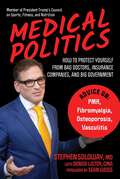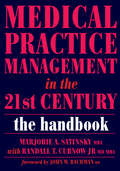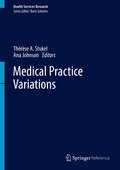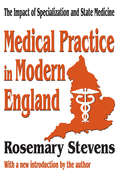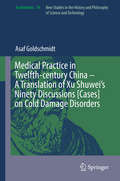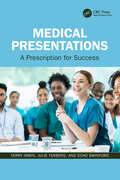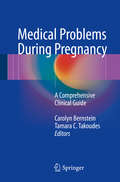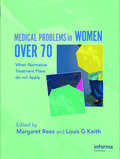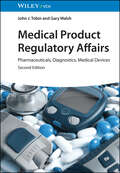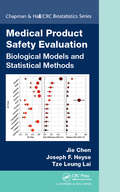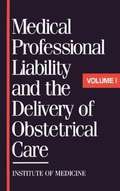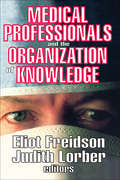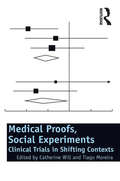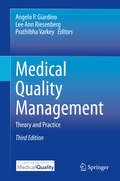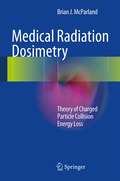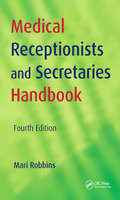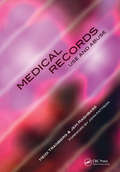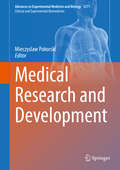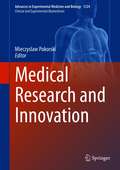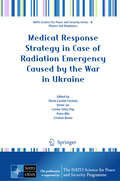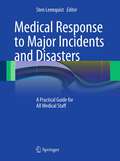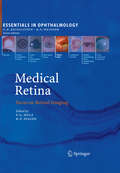- Table View
- List View
Medical Physiology: With Student Consult Online Access (12th Edition)
by John E. Hall Arthur C. GuytonThe 12th edition of Guyton and Hall Textbook of Medical Physiology continues this bestselling title's long tradition as one of the world's favorite physiology textbooks. The immense success of this book is due to its description of complex physiologic principles in language that is easy to read and understand. Now with an improved color art program, thorough updates reflecting today's medicine and science, and accessible online at studentconsult.com, this textbook is an excellent source for mastering essential human physiology knowledge. Learn and remember vital concepts easily thanks to short, easy-to-read, masterfully edited chapters and a user-friendly full-color design. See core concepts applied to real-life situations with clinical vignettes throughout the text. Discover the newest in physiology with updates that reflect the latest advances in molecular biology, cardiovascular, neurophysiology and gastrointestinal topics. Visualize physiologic principles clearly with over 1000 bold, full-color drawings and diagrams. Distinguish core concepts from more in-depth material with a layout that uses gray shading to clearly differentiate between "need-to-know" and "nice-to-know" information. Access the complete contents online at studentconsult.com along with bonus resources such as image banks, self-assessment questions, physiology animations and more! This new edition continues the long tradition of "Guyton" as one of the world's favorite physiology textbooks.
Medical Politics: How to Protect Yourself from Bad Doctors, Insurance Companies, and Big Government
by Stephen SolowayOne of America&’s top doctors rips the Band-Aid off to expose the American health care system Legislation written by drug and insurance companies, malpractice by corrupt and incompetent doctors, misguided and dishonest medical policy—the reality may be worse than you feared, and Medical Politics exposes all the secrets of a dirty American health care industry. Written by Stephen Soloway, one of America&’s top rheumatologists and a former appointee to Donald Trump&’s President's Council on Sports, Fitness, and Nutrition, this expose provides an inside look at how medical decisions are lobbied and money influences policy at the highest levels, explains how recent and upcoming medical policies will affect common Americans, and gives recommendations for a better American medical system. Featuring the author's personal letters to dirty insurance companies and other figures in the industry, Medical Politics takes readers inside Dr. Soloway's fight against Big Pharma and Big Insurance in search of better care for his patients. The result is shocking indictment of the American medical system from an insider--and charts a path for Americans to better advocate for themselves.
Medical Power and Social Knowledge (Second Edition)
by Professor Bryan S TurnerThe fully revised edition of this successful textbook provides a comprehensive introduction to medical sociology and an assessment of its significance for social theory and the social sciences. It includes a completely revised chapter on mental health and new chapters on the sociology of the body and on the relationship between health and risk in contemporary societies. <p><p> Bryan S Turner considers the ways in which different social theorists have interpreted the experience of health and disease, and the social relations and power structures involved in medical practice. He examines health as an aspect of social action and looks at the subject of health at three levels - the individual, the social and the societal. Among the perspectives analyzed are: Parsons' view of the `sick role' and the patient's relation to society; Foucault's critique of medical models of madness and sexuality; Marxist and feminist debates on the relation of health and medicine to capitalism and patriarchy; and Beck's contribution to the sociological understanding of environmental pollution and hazard in the politics of health.
Medical Practice Management in the 21st Century: The Epidemiologically Based Needs Assessment Reviews, v. 2, First Series
by Marjorie Satinsky Randall T CurnowThis title includes a Foreword by John W Bachman, Professor of Medicine, Mayo Clinic College of Medicine, Rochester, Minnesota. Mastering the art of medical practice management requires knowledge that most physicians don't learn in medical school, residency, and fellowship training. Successful practice management in the 21st century requires physicians to understand how to organize and manage a practice, manage their finances, recruit, work with, and manage people within and outside of the practice, improve healthcare delivery and clinical outcomes, and ensure compliance with federal, state, and local laws and regulations. "Medical Practice Management in the 21st Century: The Handbook" addresses multiple aspects of medical practice management. It offers both background information and practical tools. The workbook format, supported by web-based tools, allows busy physicians to gain a basic understanding of many topics, determine strategies for their practices, and seek additional information when they want it. This guide will be ideal for both physicians who need business guidance as they begin their careers and physicians who are already in practice and want to enhance their business skills. Many physicians can't afford or choose not to hire a professional practice administrator or manager; this book will help them assume managerial responsibilities with the same level of confidence that they bring to clinical care. Physicians in academic medical centers who manage departments, programs, or research studies will also benefit. "This book is essential for any clinician planning to open a new practice or attempting to improve the quality and efficiency of an existing practice. Read and learn." - John Bachman MD, in the Foreword. "Written for the busy practitioner - clear, concise, and practical without any wasted space. I wish I had had this resource when I was starting practice. It's the bible for practice management, just as the "Washington Manual" was in earlier years." - Robert S Galvin, MD, Director of Global Healthcare for General Electric. "Important. Crosses many boundaries, covering a wide variety of topics. Guides physicians in developing the infrastructure that they need to succeed." - John Fallon, MD, Chief Physician Executive, Blue Cross Blue Shield of Massachusetts. "There is no better book or resource to use to develop the necessary proficiency to run a first-class, stellar practice than this. All who read this book will be able to ensure that every patient has a positive experience with your practice and will not only enjoy the experience but will tell other physicians, their family and their friends about you and your practice and thus make your practice thrive and prosper." - Dr Neil Baum, Clinical Associate Professor of Urology, Tulane Medical School, New Orleans, Louisiana. "I love the chapter on financial management. It is very complete and gives a non-business major a good grasp of complicated information." - Allen R. Wenner, MD, family medicine practitioner, West Columbia Family Medicine, South Carolina. "I like the format of the exhibits. In the chapter on financial management, the side-by-side problem/solution approach is easily understandable and lends itself to a solution oriented approach. I can spot my own practice's issues and immediately understand what to do without searching through a lot of text." - Tom Sena, MD, President of Raleigh Children and Adolescents Medicine, Raleigh, North Carolina. "Full of good material which I am actively planning to use. Extremely helpful!" - Dr Damian McHugh, President, Raleigh Emergency Medicine Associates, Raleigh, NC.
Medical Practice Variations
by Ana Johnson Thérèse A. StukelThis title deals with internationally documented variations in medical practice and health service that exist across countries as well as regions across a specific country. Such variations raise critical concerns about the quality, equity and efficiency of health care resources across the world. Health services researchers have long been aware of large variations in the use of medical care across regions and medical providers. In the 1930s, the British pediatrician J. A. Glover observed that the rates of tonsillectomy in British schoolchildren varied widely, depending on the district where the students lived and the doctors who examined them. This volume provides a contextual landscape for the study of health care utilization through the lens of medical practice variations. It is grounded in the pioneering work by medical care epidemiologist, Dr. John Wennberg, who revealed wide variations in elective surgical rates across small areas in the U. S. and his findings that these variations were generally not explained by differences in population illness rates or patient preferences but rather, there were strong associations between supply of health care resources, such as hospital beds and physicians and health care utilization. This volume introduces the concept of medical practice variations and its early history, outlines established concepts and frameworks, with an overview of methods used to understand the variations in medical care . It makes the case for outcomes research in determining what works in health care and policy reforms to rationalize how care is delivered. Each chapter synthesizes the current published literature in the field and covers a description of medical practice variations in the area, determinants of these variations and outcomes. It outlines the most current research on specific types of utilization such as inpatient care, emergency services, elective surgery, primary care, obstetric and gynaecological care, mental health care and end-of-life care, among others. Studies of variation in condition-specific care focus on common conditions such as acute myocardial infarction, congestive heart failure, stroke, diabetes and procedures such as cancer surgery and joint replacement. Special topics include health care spending and quality, shared decision making and disparities.
Medical Practice in Modern England: The Impact of Specialization and State Medicine
by Rosemary StevensBefore World War II, the great majority of practicing doctors in England and Wales were general practitioners. They performed their own surgery, and were accustomed to treating a wide variety of illnesses and symptoms. Specialists were few in number, tended to practice in large towns, and were often associated with major hospitals. But rapidly changing medical institutions and services in the twentieth century have compelled specialization even among more modest doctors and hospitals.
Medical Practice in Twelfth-century China – A Translation of Xu Shuwei’s Ninety Discussions [Cases] on Cold Damage Disorders (Archimedes #54)
by Asaf GoldschmidtThis book is an annotated translation of Xu Shuwei’s (1080–1154) collection of 90 medical case records – Ninety Discussions of Cold Damage Disorders (shanghan jiushi lun 傷寒九十論) – which was the first such collection in China. The translation reveals patterns of social as well as medical history. This book provides the readers with a distinctive first hand perspective on twelfth-century medical practice, including medical aspects, such as nosology, diagnosis, treatment, and doctrinal reasoning supporting them. It also presents the social aspect of medical practice, detailing the various participants in the medical encounter, their role, the power relations within the encounter, and the location where the encounter occurred. Reading the translation of Xu’s cases allows the readers high-resolution snapshots of medicine and medical practice as reflected from the case records documented by this leading twelfth-century physician. The detailed introduction to the translation contextualizes Xu’s life and medical practice in the broader changes of this transformative era.
Medical Presentations: A Prescription for Success
by Echo Swinford Terry Irwin Julie Terberg“A comprehensive guide to planning, constructing, and delivering presentations. This is the missing manual that every doctor needs”.Rowan Parks, Professor of Surgical Sciences and Honorary Consultant Surgeon,University of Edinburgh; President of Royal College of Surgeons of Edinburgh“A fantastic, fool proof guide to presenting like a pro!”Alice Roberts, Professor of Public Engagement in Science, University of Birmingham; Broadcaster and AuthorThis book will teach healthcare professionals how to craft more effective and engaging PowerPoint® presentations, taking readers through the preparation of a presentation from concept to delivery. The book is based on decades of the authors’ personal experiences teaching PowerPoint® and slide design. The text is based on a sound understanding of educational theory. Readers will learn how to present interesting and visually appealing slides. In particular, the focus will be on designing professional-looking slides that convey a clear and memorable message.The book will be valuable to any healthcare professional required to put together presentations, whether a high-flying academic doctor or nurse presenting their research at international conferences, a trainee giving a talk at an in-house educational session, or a student preparing a presentation as part of their course work.
Medical Problems During Pregnancy
by Carolyn Bernstein Tamara C. TakoudesThis title will cover medical problems that arise commonly during pregnancy. When a woman is pregnant, she usually receives the bulk of medical care from her obstetrician or midwife. Medical complications and issues often arise, and recognition and acute management is critical. Case-based illustrations of common and less common issues that arise during pregnancy will be presented. One concern in the care of pregnant patients always centers around medication safety, and therefore, there will be a pharmacologic review of medication classes and the meaning of each. Standard of care often determines medication use, and this will be explored, as well as bullet points for discussion with patients. There is a real need for a comprehensive reference with guidelines for the care of pregnant patients. This up-to-date reference will be a useful tool for practicing obstetricians, primary care clinicians, family practice physicians, nurse practitioners and other allied health professionals. The book will also include wellness summaries regarding diet and exercise.
Medical Problems in Women over 70: When Normative Treatment Plans do not Apply
by Margaret Rees Louis G KeithCare of the older patient is characterized by increasing incidence of chronic and acute diseases, with many patients suffering from several conditions simultaneously. The susceptibility to disease increases not only because of physiological factors relating to the aging process, but also due to changes in lifestyle, such as decreased mobility. Issu
Medical Product Regulatory Affairs: Pharmaceuticals, Diagnostics, Medical Devices
by Gary Walsh John J. TobinMedical Product Regulatory Affairs Hands-on guide through the jungle of medical regulatory affairs for every professional involved in bringing new products to market Based on a module prepared by the authors for an MSc course offered by the University of Limerick, Ireland, Medical Product Regulatory Affairs is a comprehensive and practical guide on how pharmaceutical and medical devices are regulated within the major global markets. The Second Edition builds on the success of the first with an even wider scope and full coverage of new EU regulations on the safe use of medical devices. Following a look at drug development, complete sections are devoted to national and EU regulatory issues, manufacturing license application and retention, and regulation in the USA. Other topics dealt with include CDER, CBER and marketing and manufacturing licenses, the ICH process and Good Laboratory/Clinical/ Manufacturing Practices. Medical Product Regulatory Affairs includes information on: Aims and structure of regulation, covering purpose and principles of regulation, national and EU legislative processes, and pharmacopeia Regulatory strategy, covering product development and manufacturing, market vigilance, quality assurance systems, personnel, and documentation Drug discovery and development, covering prescription status, physical properties, therapeutic use, and drug discovery, development, and delivery Non-clinical studies, covering non-clinical study objectives and timing, pharmacological and pharmacodynamic studies, and bioavailability and bioequivalence Clinical trials, covering trial protocol, monitoring of trials, trial master files, and FDA communications The wide coverage of different product types and the main global markets makes Medical Product Regulatory Affairs ideal for training courses on regulatory affairs in academia and industry. It is also a valuable reference for pharmacologists, bioengineers, pharma engineers, and students in pharmacy to familiarize themselves with the topic.
Medical Product Safety Evaluation: Biological Models and Statistical Methods (Chapman & Hall/CRC Biostatistics Series)
by Tze Leung Lai Jie Chen Joseph HeyseMedical Product Safety Evaluation: Biological Models and Statistical Methods presents cutting-edge biological models and statistical methods that are tailored to specific objectives and data types for safety analysis and benefit-risk assessment. Some frequently encountered issues and challenges in the design and analysis of safety studies are discussed with illustrative applications and examples. <P><P>Medical Product Safety Evaluation: Biological Models and Statistical Methods presents cutting-edge biological models and statistical methods that are tailored to specific objectives and data types for safety analysis and benefit-risk assessment. Some frequently encountered issues and challenges in the design and analysis of safety studies are discussed with illustrative applications and examples. <P><P>The book is designed not only for biopharmaceutical professionals, such as statisticians, safety specialists, pharmacovigilance experts, and pharmacoepidemiologists, who can use the book as self-learning materials or in short courses or training programs, but also for graduate students in statistics and biomedical data science for a one-semester course. Each chapter provides supplements and problems as more readings and exercises.
Medical Professional Liability and the Delivery of Obstetrical Care: Volume I
by Committee To Study Medical Professional Liability The Delivery Of Obstetrical CareThis is the first part of an in-depth study focusing on medical liability and its effect on access to and delivery of obstetrical care.The book addresses such questions as:Do liability concerns impede the use of new technologies?Have liability issues affected the physician-patient relationship? Are community health and maternity centers being harmed? What specific remedies are being considered and what are their prospects for success?
Medical Professionals and the Organization of Knowledge
by Eliot Freidson Judith Lorber"Medical Professionals and Their Work" conveys how medical people shape and organize the knowledge, perception, and experience of illness, as well as the substance of illness behavior, its management, and treatment. It is now well established that the unique symbolic equipment of the human animal is intimately connected with the functioning of the body. Freidson and Lorber believe that the proper understanding of specifically human rather than generally "animal" illness requires careful and systematic study of the social meanings surrounding illness.The content of social meanings varies from culture to culture and from one historical period to another. As important as the content of those social meanings, is the organization of groups who serve as carriers and, sometimes, creators. In the case of illness, a critical difference exists between those considered to be competent to diagnose and treat the sick and those excluded from this special privilege - a separation as old as the shaman or medicine-man. Such differences become solidified when the expert healer becomes a member of an organized, full-time occupation, sustained in monopoly over the work of diagnosis and treatment by the force of the state, and invested with the authority to make official designation of the social meanings to be ascribed to physical states.The medical profession in advanced nations is in a vise between professional needs and political demands. Its organization and its knowledge establish many of the conditions for being recognizably and legitimately ill, and the professional controls many of the circumstances of treatment. It thus plays a central role in shaping the experience of being ill. With this fact of modern life in mind, this collection on the character of experts or professionals in general and of medicine as a profession in particular is uniquely fashioned.
Medical Proofs, Social Experiments: Clinical Trials in Shifting Contexts
by Tiago Moreira Catherine WillClinical trials have become key technologies for decision making in the contemporary world. Their results shape medical practice and determine priorities across health care systems, but the work that goes into producing credible data is often hidden. Medical Proofs, Social Experiments draws upon detailed case studies to argue that to understand their value, we need to pay more attention to the contexts for these modern medical experiments, recovering the diverse ways in which they involve doctors, patients and the public, the local practices that contribute to their completion, and the complex negotiation of their results in professional and statutory institutions. Presenting research from the UK, USA, Sweden and The Netherlands, the ethnographic perspective adopted by the authors provides a space to explore the investments of different state, market, professional and other actors in particular forms of evaluation, and the ways in which trial methodologies may be re-designed or re-imagined to satisfy social and political expectations. As such, this volume will be of interest to those working in the fields of science and technology studies, the sociology and anthropology of medicine and researchers of policy and organisation in health care.
Medical Quality Management: Theory and Practice
by Angelo P. Giardino Lee Ann Riesenberg Prathibha VarkeyThis comprehensive medical textbook is a compendium of the latest information on healthcare quality. The text provides knowledge about the theory and practical applications for each of the core areas that comprise the field of medical quality management as well as insight and essential briefings on the impact of new healthcare technologies and innovations on medical quality and improvement. The third edition provides significant new content related to medical quality management and quality improvement, a user-friendly format, case studies, and updated learning objectives. This textbook also serves as source material for the American Board of Medical Quality in the development of its core curriculum and certification examinations.Each chapter is designed for a review of the essential background, precepts, and exemplary practices within the topical area: Basics of Quality ImprovementData Analytics for the Improvement of Healthcare QualityUtilization Management, Case Management, and Care CoordinationEconomics and Finance in Medical Quality ManagementExternal Quality Improvement — Accreditation, Certification, and EducationThe Interface Between Quality Improvement and LawEthics and Quality ImprovementWith the new edition of Medical Quality Management: Theory and Practice, the American College of Medical Quality presents the experience and expertise of its contributors to provide the background necessary for healthcare professionals to assume the responsibilities of medical quality management in healthcare institutions, provide physicians in all medical specialties with a core body of knowledge related to medical quality management, and serve as a necessary guide for healthcare administrators and executives, academics, directors, medical and nursing students and residents, and physicians and other health practitioners.
Medical Radiation Dosimetry
by Brian J McparlandAccurate radiation dosimetry is a requirement of radiation oncology, diagnostic radiology and nuclear medicine. It is necessary so as to satisfy the needs of patient safety, therapeutic and diagnostic optimisation, and retrospective epidemiological studies of the biological effects resulting from low absorbed doses of ionising radiation. The radiation absorbed dose received by the patient is the ultimate consequence of the transfer of kinetic energy through collisions between energetic charged particles and atoms of the tissue being traversed. Thus, the ability of the medical physicist to both measure and calculate accurately patient dosimetry demands a deep understanding of the physics of charged particle interactions with matter. Interestingly, the physics of charged particle energy loss has an almost exclusively theoretical basis, thus necessitating an advanced theoretical understanding of the subject in order to apply it appropriately to the clinical regime. Each year, about one-third of the world's population is exposed to ionising radiation as a consequence of diagnostic or therapeutic medical practice. The optimisation of the resulting radiation absorbed dose received by the patient and the clinical outcome sought, whether diagnostic or therapeutic, demands accuracy in the evaluation of the radiation absorbed doses resulting from such exposures. This requirement arrises primarily from two broadly-encompassing factors: The requirement in radiation oncology for a 5% or less uncertainty in the calculation and measurement of absorbed dose so as to optimise the therapeutic ratio of the probabilities of tumour control and normal tissue complications; and The establishment and further refinement of dose reference levels used in diagnostic radiology and nuclear medicine to minimise the amount of absorbed dose for a required degree of diagnostic benefit. The radiation absorbed dose is the outcome of energetic charged particles decelerating and transferring their kinetic energy to tissue. The calculation of this energy deposition, characterised by the stopping power, is unique in that it is derived entirely from theoretical principles. This dominant role of the associated theory makes its understanding of fundamental to the calculation of the radiation absorbed dose to the patient. The theoretical development of charged particle energy loss recognised in medical physics textbooks is in general limited to basic derivations based upon classical theory, generally a simplified form of the Bohr theory. More advanced descriptions of, for example, the Bethe-Bloch quantum result usually do not go beyond the simple presentation of the result without full explanation of the theoretical development of the theory and consideration of its limitations, its dependencies upon the Born perturbation theory and the various correction factors needed to correct for the failures of that Born theory at higher orders. This is not appropriate for a full understanding of the theory that its importance deserves. The medical radiation physicist should be aware of the details of the theoretical derivations of charged particle energy loss in order to appreciate the levels of accuracy in tabular data provided in reports and the calculation methodologies used in modern Monte Carlo calculations of radiation dosimetry.
Medical Receptionists and Secretaries Handbook
by Mari RobbinsThis best-selling classic has now been fully revised, expanded and updated. It has established itself over ten years and with three previous editions as the essential handbook for study and daily reference. Medical Receptionists and Secretaries Handbook, Fourth Edition contains vital information for all staff enabling them to work efficiently and effectively both within the NHS and private medical sectors. It encourages an understanding of the importance of administrative staff in providing high standards of patient care and promotes teamwork throughout the whole healthcare environment. No medical receptionist, secretary or healthcare administrator should be without it!
Medical Records Use and Abuse
by Heidi Tranberg Jem Rashbass‘This book provides the background and practical guidance for all those of us who face challenges for the way we handle medical records. Written by a lawyer and a clinical informatician it provides the fusion between the legal issues and the practical clinical ones. There are clear explanations of the current legal framework, set in the context of real-world applications; the more complex issues that have a significant impact on Policy are also dealt with in depth. The background to ‘consent’ and the impact that implied and explicit consent can have on the way records are collect and used is particularly well covered. This book has many audiences, all of whom will gain from the easily accessible information within it. Caldicott guardians, research ethics committee members, and all those researchers and clinicians who need to analyze patient information will have a particular need for this handbook. Patients and the public should use it to understand how their healthcare information is protected and used. Its arrival could not have come at a better time’ Sir John Pattison, Former Director of Research, Analysis and Information, Department of Health, England.
Medical Research and Development (Advances in Experimental Medicine and Biology #1271)
by Mieczyslaw PokorskiThis book shares the experimental findings and views in current multidisciplinary medical science combining both basic and applied research aimed at resolving problematic health issues. The key topics address contagious diseases, in particular the epidemiology, clinical presentation, and management of influenza and influenza-like infections as well as brain tuberculosis. Pulmonary medicine is represented by articles addressing a range of practical issues, including the diagnosis, symptoms, comorbidities, and treatment of obstructive sleep apnea, a syndrome whose incidence shows a persistent upward trend worldwide. Other articles address the pathogenesis of air pollution toxicity and allergy and sensory irritation in toxic exposure studies. An intriguing relation of atopic dermatitis to depression and serotoninergic system is debated. The book attempts to integrate research into clinical work and to implement findings to improve care and to decrease suffering from diseases. It is dedicated to the practicing professionals, researchers, and all engaged in health care.
Medical Research and Innovation (Advances in Experimental Medicine and Biology #1324)
by Mieczyslaw PokorskiThis volume is dedicated to multidisciplinary research at the interface between basic biomedicine and clinical practice. This book guides best practice in the diagnosis and therapy while dealing with difficult-to-treat disorders of yet unclear etiology. Chapters address such disorders as granulomatosis with polyangiitis causing autoimmune-related multiorgan inflammation of blood vessels, increasingly widespread allergy to peanuts, occupational exposure to zinc oxide, and immunogenic responses to pneumococcal and influenza vaccination underlying their preventive effectiveness. Other hot issues deal with the proper use of fluid therapy in the perioperative period and a cognitive decline in lung transplant patients. A new physiotherapeutic approach of treating key myofascial trigger points in low-back pain appears highly beneficial in reducing patients’ disability, advancing physiotherapy of this overwhelming condition. Finally, other chapters consider ways to streamline medical management to increase the number of physicians and their availability for patients, a particularly sensitive issue in the current COVID-19 pandemic. The dissemination of clinical knowledge about high-risk and hardly controllable conditions is an inalienable part of progress in medical practice. The book is a resource for clinical specialists, general practitioners, and allied healthcare professionals.
Medical Response Strategy in Case of Radiation Emergency Caused by the War in Ukraine (NATO Science for Peace and Security Series B: Physics and Biophysics)
by Florin-Catalin Cirstoiu Victor Juc Corina Silvia Pop Petre Min Cristian BarnaThis book addresses a potential radiation incident caused by the war in Ukraine, from an interdisciplinary approach of medical, nuclear safety and security, nuclear research, geostrategic and population’s resilience perspectives. The book also address the key role played by NATO in identifying new solutions for stabilizing the region, while also focusing on the emergency preparedness in order to ensure that adequate capabilities and capacity are in place which can be mobilized in response to a radiation emergency.Russia's military invasion in Ukraine is considered the most serious security crisis in Central and Eastern Europe since the end of the Cold War, with major implications for the regional security environment and NATO. Since the very beginning of Russia's illegal military invasion in Ukraine the Heads of State and Government of the member countries of the North Atlantic Alliance condemned the invasion and demand that Russia should stop and withdraw its forces from Ukraine, being deeply concerned that the violence and insecurity in the region caused by Russia are determining a critical humanitarian situation and material destruction all over Ukraine.Moreover, after invading Ukraine, Russian army took control of the Zaporizhzhia nuclear power plant, in early March, 2022. Since then, Russian military units guard the facility and, after Russian President Vladimir Putin annexed up to 18% of Ukraine, including the area where the nuclear plant is located, he signed a decree to formalize Russian control over the plant.
Medical Response to Major Incidents and Disasters
by Sten LennquistThis book, written by members of the core faculty responsible for European courses on Medical Response to Major Incidents (MRMI), is a practical guide for all medical staff on how to respond to a wide range of disaster scenarios. The entire spectrum of knowledge is covered, from command and coordination through to the management of individual casualties. Central importance is attached to the key component of decision making by explaining what needs to be done for patients in particular situations and the required order and timing of treatment measures. Simplified methods receive due attention, as it is often necessary for medical staff to administer primary treatment outside of their own specialty. This book will prove an invaluable aid to all who may be involved in the response to major accidents and disasters, including medical and nursing students, ambulance crew, and military personnel as well as medical specialists.
Medical Retina
by Frank G Holz Richard F. SpaideRecent advances in ophthalmic imaging technology have revolutionized fundus examination and contributed significantly in elucidating the pathophysiology of retinal diseases and improving their diagnosis and treatment. It is therefore fitting that this detailed full-color textbook in the Medical Retina series is devoted to ocular imaging. The volume reviews in detail the role of both established and novel forms of imaging, and is designed to be of benefit to clinicians and researchers alike. All of the chapters have been written by internationally recognized experts at the forefront of their fields. The result is a comprehensive, state-of-the-art overview of retinal imaging that should prove informative and useful for everyone interested in the retina. Topics include: *Spectral domain optical coherence tomography (SD-OCT) of macular diseases *Comparison of OCT equipment *Simultaneous SD-OCT and confocal SLO imaging *Ultra-widefield imaging °Autofluorescence imaging *Near-infrared imaging *Macular pigment imaging *Metabolic mapping *Imaging of the choroid *Imaging the vitreous and the vitreoretinal interface with SD-OCT *New developments in OCT technology *Molecular imaging
Medical Risk Prediction Models: With Ties to Machine Learning (Chapman & Hall/CRC Biostatistics Series)
by Thomas A. Gerds Michael W. KattanMedical Risk Prediction Models: With Ties to Machine Learning is a hands-on book for clinicians, epidemiologists, and professional statisticians who need to make or evaluate a statistical prediction model based on data. The subject of the book is the patient’s individualized probability of a medical event within a given time horizon. Gerds and Kattan describe the mathematical details of making and evaluating a statistical prediction model in a highly pedagogical manner while avoiding mathematical notation. Read this book when you are in doubt about whether a Cox regression model predicts better than a random survival forest. Features: All you need to know to correctly make an online risk calculator from scratch Discrimination, calibration, and predictive performance with censored data and competing risks R-code and illustrative examples Interpretation of prediction performance via benchmarks Comparison and combination of rival modeling strategies via cross-validation Thomas A. Gerds is a professor at the Biostatistics Unit at the University of Copenhagen and is affiliated with the Danish Heart Foundation. He is the author of several R-packages on CRAN and has taught statistics courses to non-statisticians for many years. Michael W. Kattan is a highly cited author and Chair of the Department of Quantitative Health Sciences at Cleveland Clinic. He is a Fellow of the American Statistical Association and has received two awards from the Society for Medical Decision Making: the Eugene L. Saenger Award for Distinguished Service, and the John M. Eisenberg Award for Practical Application of Medical Decision-Making Research.
